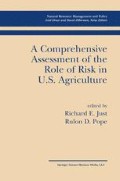Abstract
The assumption that a decision maker maximizes expected utility has been, and still is, a frequently employed model specification. This is true in economics and in agricultural economics. Decision models, where maximization of expected utility is the goal of the decision maker, have developed significantly during the forty or so years they have been in use. There now exists a substantial set of definitions, theorems, and empirical procedures available to those applying this paradigm. The goal of this chapter is to briefly describe the development of this expected utility (EU) decision model and to describe in some detail its current state.
Access this chapter
Tax calculation will be finalised at checkout
Purchases are for personal use only
Preview
Unable to display preview. Download preview PDF.
References
Allais, M. 1953. “Le Comportement de l’Homme Rationnel Devant le Risque: Critique des Postulats et Axiomes de l’Ecole Américaine.” Econometrica 21: 503–546.
Anderson, J.R., J.L. Dillon, and J.B. Hardaker. 1977. Agricultural Decision Analysis. Ames: Iowa State University Press.
Arrow, K.J. 1965. Aspects of the Theory of Risk Bearing. Helsinki: Yrjo Jahnsson in Saatio.
Arrow, K.J. 1971. Essays in the Theory o Risk Bearing. Chicago: Markham.
Baron, D. 1970. “Price Uncertainty, Utility, and Industry Equilibrium in Pure Competition.” International Economic Review 11: 463–480.
Eeckhoudt, L., and C. Gollier. 1995. “Demand for Risky Assets and the Monotone Probability Ratio.” Journal of Risk and Uncertainty 11: 113–122.
Gollier, C. 1995. “The Comparative Statics of Changes in Risk Revisited.” Journal of Economic Theory 66: 522–535.
Gollier, C., and J.W. Pratt. 1996. “Risk Vulnerability and the Tempering Effect of Background Risk.” Econometrica 64: 1109–1123.
Hadar, J., and W.R. Russell. 1969. “Rules for Ordering Uncertain Prospects.” American Economic Review 59: 25–34.
Hanoch, G., and H. Levy. 1969. “Efficiency Analysis of Choices Involving Risk.” Review of Economic Studies 38: 335–346.
Just, R.E., and R.D. Pope. 1978. “Stochastic Specification of Production Functions and Economic Implications.” Journal of Econometrics 7: 67–86.
Kimball, M. 1990. “Precautionary Saving in the Small and in the Large.” Econometrica 58: 53–74.
Kimball, M. 1993. “Standard Risk Aversion.” Econometrica 61: 589–611.
King, R.P., and L.J. Robison. 1981. “An Interval Approach to the Measurement of Decision”
Maker Preferences. American Journal of Agricultural Economics 63: 510–520.
Landsberger, M., and I. Meilijson. 1990. “Demand for Risky Financial Assets: A Portfolio Analysis.” Journal of Economic Theory 50: 204–213.
Leland, H. “Theory of the Firm Facing Uncertain Demand.” American Economic Review 62: 278–291.
Machina, M. 1982. “`Expected Utility’ Analysis Without the Independence Axiom.” Econometrica 50: 277–323.
Choice Under Uncertainty: Problems Solved and Unsolved. Journal of Economic Perspectives 1:121–154.
Meyer, J. 1977. “Choice Among Distributions.” Journal of Economic Theory 14: 326–336.
Meyer, J., and M.B. Ormiston. 1989. “Deterministic Transformations of Random Variables and the Comparative Statics of Risk.” Journal of Risk and Uncertainty 2: 179–188.
Pope, R.D., and R.F. Ziemer. 1984. “Stochastic Efficiency, Normality, and Sampling Errors in Agricultural Risk Analysis.” American Journal of Agricultural Economics 66: 31–40.
Pratt, J.W. 1964. “Risk Aversion in the Small and in the Large.” Econometrica 32: 122–136.
Pratt, J., and R.J. Zeckhauser. 1987. “Proper Risk Aversion.” Econometrica 55: 143–154.
Quiggin, J. 1982. “A Theory of Anticipated Utility.” Journal of Economic Behavior and Organization 3: 323–343.
Rothschild, M., and J.E. Stiglitz. 1970. “Increasing Risk I: A Definition.” Journal of Economic Theory 2: 225–243.
Rothschild, M., and J.E. Stiglitz. 1971. “Increasing Risk II: Its Consequences.” Journal of Economic Theory 3: 66–84.
Sandmo, A. 1971. “On the Theory of the Competitive Firm Under Price Uncertainty.” American Economic Review 61: 65–73.
Savage, L. 1954. The Foundations of Statistics. New York: John Wiley and Sons.
Tobin, J. 1958. “Liquidity Preference as Behavior Towards Risk.” Review of Economic Studies 25: 65–86.
von Neumann, J., and O. Morgenstern. 1944. Theory of Games and Economic Behavior. Princeton: Princeton University Press.
Whitmore, G.A. 1970. “Third-Degree Stochastic Dominance.” American Economic Review 60: 457–459.
Author information
Authors and Affiliations
Editor information
Editors and Affiliations
Rights and permissions
Copyright information
© 2002 Springer Science+Business Media New York
About this chapter
Cite this chapter
Meyer, J. (2002). Expected Utility as a Paradigm for Decision Making in Agriculture. In: Just, R.E., Pope, R.D. (eds) A Comprehensive Assessment of the Role of Risk in U.S. Agriculture. Natural Resource Management and Policy, vol 23. Springer, Boston, MA. https://doi.org/10.1007/978-1-4757-3583-3_1
Download citation
DOI: https://doi.org/10.1007/978-1-4757-3583-3_1
Publisher Name: Springer, Boston, MA
Print ISBN: 978-1-4419-4924-0
Online ISBN: 978-1-4757-3583-3
eBook Packages: Springer Book Archive

